An atom of element X contains 3 protons, 3 electrons and 4 neutrons:
Write the electronic configuration of the element
To determine the electronic configuration of element X, which has 3 protons, 3 electrons, and 4 neutrons, we can follow these steps:
Step 1: Identify the Atomic Number
The atomic number (Z) of an element is equal to the number of protons in its nucleus. Since element X has 3 protons, its atomic number is:
Z=3
Step 2: Determine the Electron Configuration
The electron configuration describes how electrons are distributed among the various atomic orbitals. For an atom, the number of electrons is equal to the number of protons in a neutral atom. Therefore, element X has 3 electrons.
Step 3: Fill the Electron Shells
Electrons fill the shells in the following order:
1. The first shell (K shell) can hold a maximum of 2 electrons.
2. The second shell (L shell) can hold a maximum of 8 electrons.
Since element X has 3 electrons:
- The first 2 electrons will fill the K shell.
- The remaining 1 electron will go into the L shell.
Step 4: Write the Electronic Configuration
The electronic configuration for element X can be written as:
1s22s1
This indicates that there are 2 electrons in the first shell (K) and 1 electron in the second shell (L).
Final Answer
The electronic configuration of element X is:
1s22s1
---
The atomic number (Z) of an element is equal to the number of protons in its nucleus. Since element X has 3 protons, its atomic number is:
Z=3
The electron configuration describes how electrons are distributed among the various atomic orbitals. For an atom, the number of electrons is equal to the number of protons in a neutral atom. Therefore, element X has 3 electrons.
Electrons fill the shells in the following order:
1. The first shell (K shell) can hold a maximum of 2 electrons.
2. The second shell (L shell) can hold a maximum of 8 electrons.
- The first 2 electrons will fill the K shell.
- The remaining 1 electron will go into the L shell.
The electronic configuration for element X can be written as:
1s22s1
This indicates that there are 2 electrons in the first shell (K) and 1 electron in the second shell (L).
The electronic configuration of element X is:
1s22s1
Topper's Solved these Questions
- ATOMIC STRUCTUREBook:S CHAND IIT JEE FOUNDATIONChapter:ATOMIC STRUCTUREExercise:QUESTION BANK-20 ( Answer the following questions )
Explore 4 Videos
- ATOMIC STRUCTUREBook:S CHAND IIT JEE FOUNDATIONChapter:ATOMIC STRUCTUREExercise:SELF ASSESSMENT SHEET -20
Explore 23 Videos
- ATOMIC STRUCTUREBook:S CHAND IIT JEE FOUNDATIONChapter:ATOMIC STRUCTUREExercise:QUESTION BANK-20 (FILL IN THE BLANKS WITH APPROPRIATE WORDS TO MAKE CORRECT STATEMENTS. )
Explore 10 Videos
- CARBON AND ITS COMPOUNDS Book:S CHAND IIT JEE FOUNDATIONChapter:CARBON AND ITS COMPOUNDS Exercise:SELF ASSESSMENT SHEET-19
Explore 24 Videos
Similar Questions
Knowledge Check

Write electronic configuration of element E.A2,8,3B2,8,6C2,8,5D2,8
An atom of element X contains 3 protons, 3 electrons and 4 neutrons:
What is its atomic number?
View SolutionAn atom of element X contains 3 protons, 3 electrons and 4 neutrons:
What is its mass number?
View SolutionAn atom of element X contains 3 protons, 3 electrons and 4 neutrons:
Write the symbols of the ion formed by an atom of element X.
View SolutionAn atom of an element contains "29" electrons and "35" neutrons. The electronic configuration of the element is
View SolutionWrite general electronic configuration of p-block elements.
View SolutionAn atom of element X contains 3 protons, 3 electrons and 4 neutrons:
What type of ion, cation or anion, will be formed by an atom of element X? Why?
View SolutionAn atom of element X contains 3 protons, 3 electrons and 4 neutrons:
State whether element X is a metal or non-metal. Why?
View Solution
